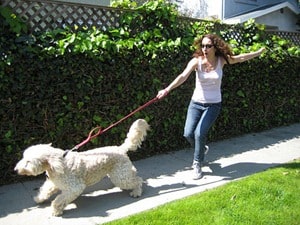Dogs are like people: they do not like to be pushed. If you push against your dog’s chest, she will push back. It’s instinct. That’s great if you’re driving a team of sled dogs – but not if you are trying to walk an untrained dog. The more a dog’s collar presses into her neck as she merrily bounces forward, the harder she’ll pull away. She can’t help herself. But that doesn’t mean you can’t help her. Now that you know what makes her pull at the leash, it’s easier to understand how you can train her – and yourself – to keep it from happening.
First, you have to remember that the walk does not begin as soon as you hit the sidewalk but the moment you pick up the leash. If your dog is like most dogs, she loves to go for walks with you, and she very quickly associates the leash with the walk. Just seeing it in your hand is enough to send many puppies and untrained dogs into a frenzy and a mad rush toward the door. This is where the training must begin. If your dog is doing an ecstatic happy dance by the door and you walk toward her to connect the leash, you’ve already lost ground. You’ve rewarded her for doing something you do not want her to do.

Once she’s on the leash, if she makes any move toward the door before you issue her release command, bring her back and tell her to sit and stay once more. Not until she sits quietly on her lead until you release her should you move closer to the door. Once you release her, let her walk toward the door.
Imagine you are balancing an egg on your leash hand; the goal is to make it to the door without sending the “egg” to the floor. If she can make it all the way to the door with the leash remaining slack, have her sit-stay while you open the door. If, once you release her, she immediately lunges for the door or pulls the leash taut – that is, causes the hypothetical egg to drop – take her back to the original position and begin again. You might get only two or three feet with the leash remaining loose, but be patient. When she makes it, don’t forget to reward her. She will soon realize that the fastest way to get to the door is not to run there but to wait until you walk her there.
She should remain sitting quietly while you open the door. If she doesn’t, close the door and wait until she does. By now you should begin to see the pattern here: reward the desired behavior, not the behavior you want to change. There’s no punishment here, just the withholding of the grand prize – the walk! – until she learns to play by the rules. It should come as no surprise, then, that when you do finally make it to the sidewalk (and you will), you and she are going to proceed in very much the same way. You hold the leash, and as long as it remains slack, she gets to walk forward, and you reward her with both praise (or a click) and the freedom to move itself. If she goes too fast and pulls on the leash, don’t say anything, just stop moving, and take a few steps backward. Pull – don’t yank – her back with you. Have her sit-stay for ten seconds or so before you continue.
The reason for saying nothing is that you want her to make the association with the feel of the collar when she is forging ahead with the fact that doing so actually slows down her progress – that as long as she lets the leash stay slack, she gets to move forward, and can get to the park, or wherever you are headed, that much more quickly. When she’s walking correctly, praise her. The important thing is to be consistent: if she’s pulling on the leash, you stop, and if she’s walking with slack on the lead, you praise her.
At all times, keep the dog more or less to your left, and don’t let her criss-cross back and forth on the path. She knows exactly what will happen if she walks around something like a sign or a light pole. Don’t let her do it. If she does manage to get herself wound around something, let her extricate herself.
Remember, it is up to you to do your part. Don’t trick the poor dog with an uneven pace, or change your idea midway of what constitutes slack. In general, if the leash is dropping but not dragging, she’s doing fine. If it’s taut, she is pulling – unless, of course, it is you who is pulling. If she is walking fine and at a steady pace and you slow or stop, don’t blame her! If you feel the need to halt in front of a shop window, halt her, too, with sit and stay. And reward her when she does.
